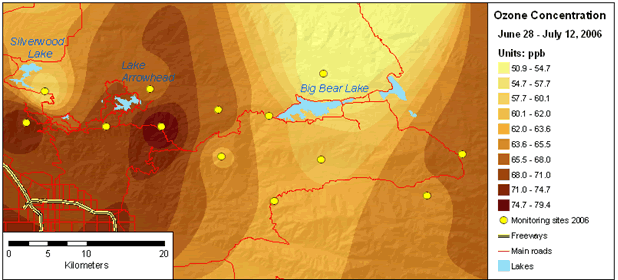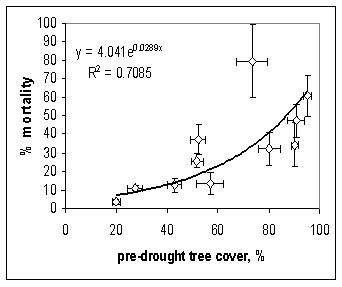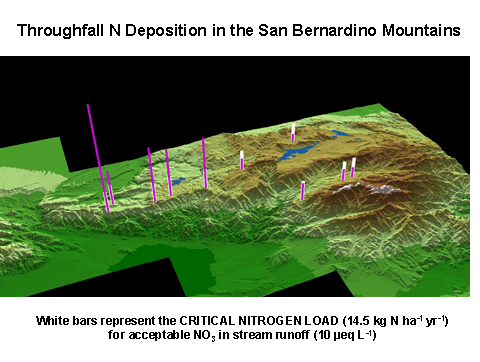Climate Change and...
Case studies
Web sites
Air Pollution and Climate Change
Preparers: Nancy Grulke, Project Leader, and Susan Schilling, Computer Specialist, Atmospheric Deposition on Western Ecosystems, Pacific Southwest Research Station
Issues
Non-CO2 air pollution (such as ozone (O3), nitrogen (N), particulates) is an under-acknowledged component of climate change.
Ozone is a secondary product of fossil fuel combustion. Although the effect of O3 on ecosystem carbon sequestration has been recently highlighted(Sitch et al. 2007), high concentrations of tropospheric O3 are widely viewed as an urban problem. The current global tropospheric O3 concentration is already double that of preindustrial times, however, and is expected to increase by an additional 50 percent by 2020.
Excessive nitrogen (N) deposition, a by product of fossil fuel combustion, animal husbandry, and intensive use of fertilizers, is persistently nudging ecosystem processes along unknown paths and leading to deterioration of downstream water quality.
Airborne particulates come from many sources, including secondary pollutants formed by chemical reactions of pollutant gases, dust particles discharged from road surface by traffic, and particles emitted by industrial and agricultural activities. Fine particulates (2.5 micrometers in diameter or smaller) are known to harm human health. Recently fine particulates have been shown to decrease precipitation in areas downwind of their production. Fine particulates have also been shown to reduce photosynthetic activity and ultimately growth of plant species endemic to calcareous soils.
Likely changes
Research indicates forests in southern California will become more susceptible to wildfire as air pollution increases.
Scientists at the Pacific Southwest Research Station have developed inexpensive air monitoring techniques for measuring O3 levels over remote forested areas and have mapped areas at greatest risk. They have found that high concentrations of O3 increase transpiration and thus exacerbate tree drought stress, increasing vulnerability to insect attacks and wildfire.

Figure 1—Pollution gradient across the San Bernardino Mountains. Contributed by Andrzej Bytnerowicz.
Further research indicates (1) O3 exposure may negate the positive effects of increased atmospheric CO2 on plant growth and (2) moderately high O3 concentrations (in excess of 70 parts per billion [ppb]) increases plant water los sand risk of drought stress. These observations have been made at the leaf level and support the whole ecosystem flux observations at the Aspen FACE experiment in northern Wisconsin (Karnosky et al. 2005), and the CASIROZ experiment in southern Germany (Matyssek et al. 2007).
Related research indicates that long-term N deposition in the mountains east of Los Angeles has contributed to stand densification, increased the level of drought stress, exacerbated the level of tree mortality during the recent drought, and has significantly contributed to poor stream water quality.
Figure 2 illustrates the level of tree mortality expected with increasing stand density. These data were collected from aerial imagery from 11 stands in the San Bernardino Mountains in 1994 (predrought) and 2004 (postdrought), and indicate that low mortality rates can result if tree canopy cover (and density) is kept low(<15percent) even during a severe 4-year drought (1999-2002). Two of the stands with the lowest mortality had prescribed burns prior to the drought.

Figure 2—Increased tree cover was highly correlated with tree mortality after 4 years of drought stress. Contributed by Nancy Grulke and Rich Minnich.
Climate change will affect both the input sand outputs of N from forests and other ecosystems. The dynamics of nitrate export in stream water and groundwater is expected to change. Peak concentrations of nitrates in stream water are likely to increase if runoff flows increase owing to a greater proportion of precipitation occurring as rainfall as opposed to snow, or as a result of more rapid snow melt, or both.

Figure 3—Nitrogen deposition across the San Bernardino Mountains measured by "through fall," the hydrologic flux of nutrients from the canopy to the forest floor.The pink bars represent total N deposition at each site in micro equivalents per liter, whereas white bars indicate the level of N deposition that results in unacceptably high nitrate levels in stream water.
Options for Management
Where forests are strongly affected by air pollution and drought, the key to their management is to thin stands, both for water conservation and to improve carbon sequestration via increased individual tree production.
Recommended Reading
Bytnerowicz, A.; Omasa, K.; Paoletti, E. 2007. Integrated effects of air pollution and climate change on forest: a northern hemisphere perspective. Environmental Pollution. 147: 438-445.
Fenn, M.E.; Poth, M.A.; Aber, J.D.; Baron, J.S.; Bormann, B.T.; Johnson, D.W.; Lemly, A.D.; McNulty, S.G.; Ryan, D.F.; Stottlemeyer, R. 1998. Nitrogen excess in North American ecosystems: predisposing factors, ecosystem responses, and management strategies. Ecological Applications. 8: 706-733.
Fenn, M.E.; Poth, M.A. 1999. Temporal and spatial trends in stream water nitrate concentrations in the San Bernardino Mountains, southern California. Journal of Environmental Quality. 28: 822-836.
Fenn, M.E.; Poth, M.A.; Bytnerowicz, A.; Sickman, J. O.; Takemoto, B.K. 2003. Effects of ozone, nitrogen deposition,and other stressors on montane ecosystems in the Sierra Nevada. In: Bytnerowicz, A.; Arbaugh, M.J.; Alonso, R., eds.
Developments in environmental science. Volume 2: Ozone air pollution in the Sierra Nevada: distribution and effects on forests. Amsterdam, The Netherlands:Elsevier: 111-155.
Garner, J.; Lewis, T.; Hogsett, W.; Andersen, C.; Lefohn, A.; Karnosky, D.; Nannini, M.; Grulke, N.; Adams, R.; Heath, R.; Runeckle, V.; Chappelka, A.; Massman, W.; Musselman, R.; Woodbury, P. 2006. Environmental Effects on vegetation and ecosystems. In: Air quality criteria for ozone and related photochemical oxidants. 600/R-05/004aF. Research Triangle Park, NC: Environmental Protection Agency, National Center for Environmental Assessment, Vol.1, chapter 9. 30 cp.
Grulke, N.E. 2003. Physiological basis of ozone injury assessment in Sierra Nevada conifers. In: Bytnerowicz, A., Arbaugh,
M., Alonso, R., eds. Assessment of ozone distribution and its effects on Sierra Nevada ecosystems. Developments in Environmental Science. The Hague, Netherlands: Elsevier. Vol. 2:55-81.
Paoletti, E.; Bytnerowicz, A.; Andersen, C.; Augustatitis, A.; Marco, F.; Grulke, N.; Gunthardt-Goerg, M.; Innes, J.; Johnson, D.; Karnosky, D.; Luangjame, J.; Matyssek, R.; McNulty, S.; Muller-Starchk, G.; Musselman, R.; Percy, K.2007. Impacts of air pollution and climate change on forest ecosystems: emerging research needs. The Scientific World. 7(S1): 1-8. DOI 10.1100/tsw.207.52
Useful Links
Air pollution and global change impacts on Western forests: http://www.fs.fed.us/psw/programs/atdep/
Monitoring: ion exchange resin columns for measuring through fall and bulk deposition to forests: http://www.fs.fed.us/psw/topics/air_quality/resin_collectors/index.shtml
References Cited
Matyssek, R.; Bahnweg, G.; Ceulemans, R. [et al.]. 2007. Synopsis of the CASIROZ case study: carbon sink strength of Fagus sylvatica L. in a changing environment–experimental risk assessment of mitigation by chronic ozone impact. Plant Biology. 9: 163-180.
Karnosky, D.F.; Pregitzer, K.S.; Zak, D.R.[et al.]. 2005. Scaling ozone responses of forest trees to the ecosystem level in a changing climate. Plant, Cell and Environment. 28: 965-981.
Sitch,S.; Cox, P.M.; Collins, W.J.; Huntingford, C. 2007. Indirect radiative forcing of climate change through ozone effects on the land-carbon sink. Nature. 448: 791-794.
Crucial Questions
- How will climate change (mediated by changes in precipitation, air humidity,and wind patterns) modify pollutant deposition to landscapes and vegetation?
- How do prescribed fires and wildfires contribute to regional air quality?
- How will forest and chaparral ecosystems continue to respond to long-term, compounded disturbances? How will these disturbances affect ecosystem services?
- How can uninhabited lands be managed to increase N and Cretention, reduce greenhouse gas emissions, conserve water, and yet improve downstream water quality?
- How can vegetation management be used as a strategic tool in mitigating human impact across the range of urban to uninhabited ecosystems?
Ongoing research
We are investigating the role of prescribed fires, and wildfires on background, regional O3 concentrations. This is particularly important to land managers that need to consider air quality prior to fuels treatments to reduce the risk of wildfire. We are also mapping current concentrations of air pollution in the southern California and the San Bernardino Mountains.
With university and other agency cooperators,we are identifying critical N loading levels that significantly affect sensitive ecosystems nationally, and are developing a better understanding of the effects of N loading on biogeochemical processes known to affect water quality. We will continue to investigate the interactive effects of environmental stress or using a combination of experimental evidence and simulation models. This research will be used to better inform managers on how uninhabited lands could be better managed to increase nitrogen and carbon retention, reduce greenhouse gas emissions, conserve water, and improve downstream water quality.
Recommended Citation
Grulke, Nancy; Schilling, Susan. 2008. Air Pollution and Climate Change. (July 28, 2008). U.S. Department of Agriculture, Forest Service, Climate Change Resource Center. http://www.fs.fed.us/ccrc/topics/air-pollution.shtml
